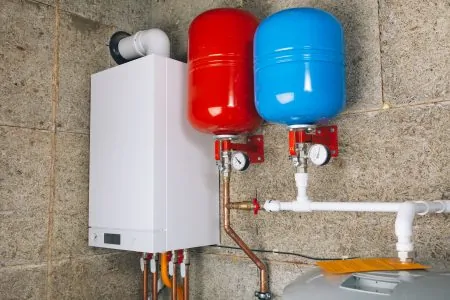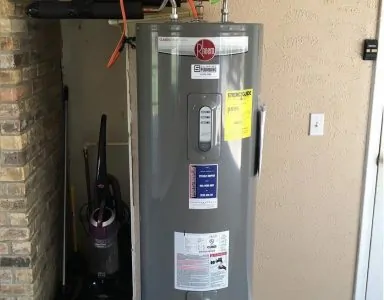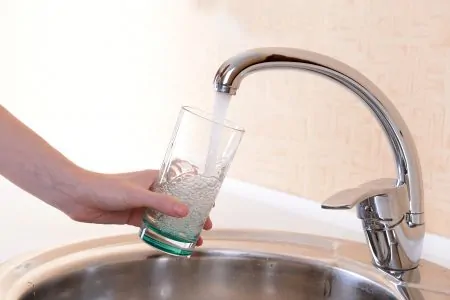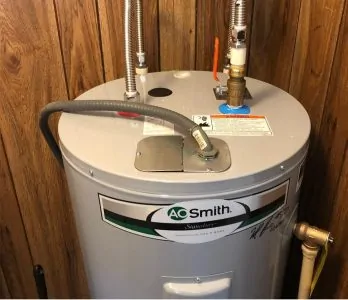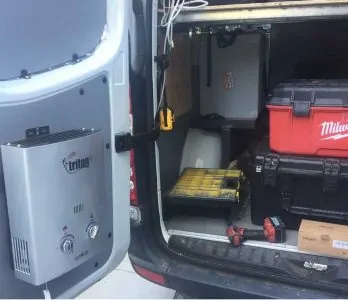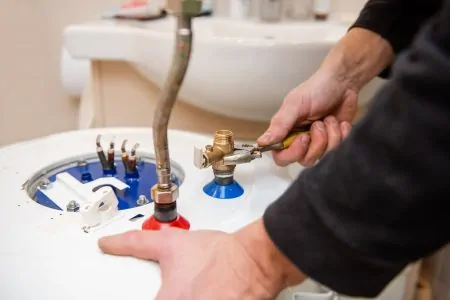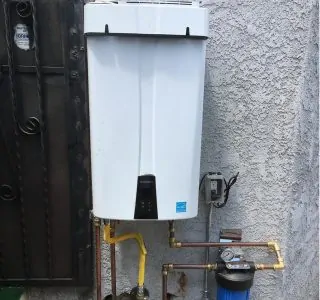Do you have a closed water supply system? If so, you might need a water heater expansion tank.
What exactly is a water heater expansion tank? Why would you need one and is it possible to get by without one?
In this article, we will explain everything you need to know about water heater expansion tanks. We will also take a look at some of the common problems with expansion tanks and how you can solve them.
Key Takeaways
- Water heater expansion tanks are necessary for closed water supply systems to manage thermal expansion and protect pipes.
- Expansion tanks come in sizes typically ranging from 2 to 5 gallons and should be chosen based on your water heater’s capacity and water pressure.
- Installing an expansion tank involves connecting it to the cold water line and adjusting the air pressure to match your home’s water pressure.
- Regularly check your expansion tank for waterlogging or other issues, and replace it every 5 to 10 years to ensure optimal performance.
Open vs Closed Water Supply Systems
Whether or not you need a water heater expansion tank depends on both your unit type and your water supply. If you have a tankless water heater, you don’t need to worry about getting an expansion tank.
You also don’t need one if your home is part of an open water supply system. When a plumbing system is “open,” it has the ability to flow back into the city’s water supply.
A closed system is the opposite of this. Water can flow into your home but the only way it can flow out again is from your faucets or shower.
What Are Water Heater Expansion Tanks?
To heat the water in your home, your water heater uses thermal expansion (1). As the name suggests, the water inside your unit expands as it gets warmer. This is true whether you have a gas or electric heater.
Thermal expansion places a strain on your pipes if the water has nowhere else to go.
As most households have a closed water supply, expansion tanks are required with any traditional tank water heater. These tanks are essential for prolonging the lifespan of your unit and will also protect your pipes.
An expansion tank is important because it can hold the extra water volume after it expands, acting as a sort of overflow. It also helps to regulate the pressure of your water.
How to Install a Water Expansion Tank
If you need an expansion tank, your next task is to figure out what size tank you should choose. The appropriate size depends on the size of your water heater as well as the water pressure in your system.
Which size tank you need will vary depending on the expansion tank manufacturer. Each manufacturer provides a guide that explains which of their tanks are suitable for your requirements.
An expansion tank that is larger than necessary won’t cause any issues. However, a tank that’s too small can cause pipe leaks as the pressure relief valve is forced to work harder to keep up.
To check your water pressure, use a pressure gauge on your pressure relief valve and periodically check the reading over 24 hours. The recommended water pressure is 50-60 PSI. If it’s any higher than that, you will need to make sure that you also have a pressure-reducing valve.
Pressure-reducing valves help ensure steady pressure throughout your system. They regulate the water hammering and work with your pressure relief valve to protect your water heater and pipes (2).
Most expansion tanks are available in either a two or five-gallon size. Once you have your tank, you will need to connect it to the cold water line. Here is how to retrofit it to your system.
- Solder a T fitting or use a saddle valve that bolts onto the pipe.
- Adjust the air pressure in your expansion tank with a tire gauge. The air pressure should match the maximum water pressure in your home.
- To add more air into the tank, use a hand pump rather than an electric pump. Using an electric air pump could cause the tank to blow.
- Attach the tank to your cold water line. It should fit where you installed your T fitting or saddle valve.
- Turn on your hot water faucet until a steady stream flows.
Replacing an Old Tank
If you find yourself needing to replace your existing expansion tank, here’s what to do (3):
- Locate your old tank: They are usually found right next to your water heater.
- Record your old tank’s measurements and information: You will need the dimensions and connections to make sure you buy the right replacement.
- Find your desired expansion tank.
- Turn off your power and water supplies: You can do this by closing the shut-off valve. You will need to give your water heater about an hour to cool down.
- Drain the water from your water heater: Open the bleeder valve and let the water drain into a bucket.
- Disconnect your old expansion tank.
- Pressurize your new tank: Make sure the tank starts at zero and use a bicycle pump to get it up to 12 PSI or the amount recommended by the manufacturer.
- Check the pressure and use Teflon tape: The tape should only be wrapped around the ends of your connectors.
- Install your new expansion tank.
- Turn on your water supply: Open a faucet and see if you have running water. You should also check for any leaks.
- Turn on the power supply and water heater: Once the system has heated up, test your hot water.
How Much Do Expansion Tanks Cost?
Expansion tanks typically cost between $40 and $70 (4). When considering your budget, you should decide whether you plan to install the tank yourself or hire a professional. If you aren’t confident dealing with electrical and plumbing lines, we recommend the latter.
If you decide to hire someone, you also need to factor in the cost of installation. Labor costs vary for each company. Taking even a brief look online, we’ve found companies that charge anywhere from $150 to $800+ to install an expansion tank.
Troubleshooting Your Expansion Tank
No system is perfect and there are sure to be times when you encounter issues with your expansion tank. These problems could stem from the wrong size tank, but it might also be that something is wrong with your heater.
If your expansion tank loses its air cushion, the pressure during each “on cycle” can be too high. This can wreak havoc on your water heater’s pressure relief valve (5).
Older expansion tanks don’t have an internal bladder to separate air and water. If your unit is older, you may experience a loss of hot water. This commonly happens when air mixes with hot water in the system.
Waterlogging
In time, your expansion tank can become waterlogged. This can happen for a few reasons.
In older systems without a bladder, waterlogging happens when air finds its way in and out of the tank. When you lose air, you also lose air pressure, causing the water in the tank to become stagnant. If this happens, you might need to drain your system.
However, if you have a newer system and your tank gets waterlogged, it’s possible that the internal bladder has ruptured. Waterlogging in a newer system could also be due to pinhole leaks in your tank.
FAQs
Conclusion
Expansion tanks aren’t just another add-on that plumbers try to sell you. These tanks are an essential safety feature and ensure your home has enough hot water and stays flood-free.
If you have a traditional tank heater, go and check that you have an expansion tank. If you do, great, but if not, check whether or not you have a closed-supply system. If you don’t have an expansion tank and your water supply system is closed, call a professional or go and buy a tank.
